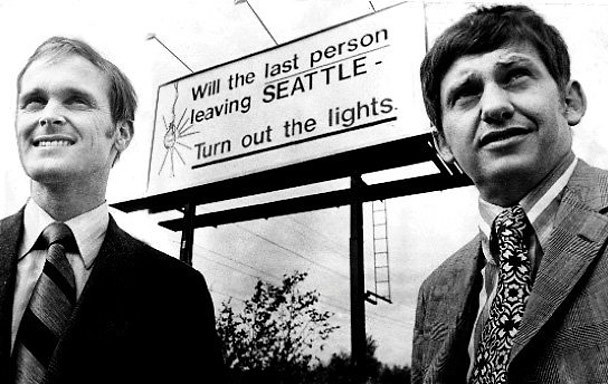Could a few entrepreneurs, even wildly successful ones like Bill Gates, Paul Allen and Jeff Bezos, rescue an entire city from collapse? A new essay by Andrew Yang in Fast Company, “The Entrepreneurs Who Saved Seattle,” credits the Microsoft and Amazon founders almost wholly with Seattle’s renaissance. The openings of Yang’s article and “City of Despair,” the 1971 Economist piece he references, which interestingly demonstrates the downside of a company town.
_________________________
From “The Entrepreneurs Who Saved Seattle,” 2014:
“Today, Seattle is considered one of the most desirable places to live and work in the U.S. Amazon, Starbucks, Expedia, and other leading companies make their homes there.
But in 1979, Seattle was the last place you’d think to find a growth business. It had more in common with today’s Rust Belt than Silicon Valley–its economy centered on a declining manufacturing base and the lumber industry, both of which were shedding jobs. Starbucks was just a tiny local company with three stores serving standard-issue coffee. The Economist had labeled Seattle the ‘city of despair’ and a billboard appeared saying “Will the last person leaving Seattle–turn off the lights.’
So what changed? Two Seattle natives decided to move their 13-employee company there in 1979 from Albuquerque. The two natives were Bill Gates and Paul Allen. And the company was Microsoft.
Is it possible to ascribe Seattle’s entire economic trajectory to just one company? Well, today over 40,000 people work at Microsoft in the region, and 28,000 of them are highly paid engineers. Approximately 4,000 businesses have been started by Microsoft alumni, many of which are in the region. Just one of these companies, RealNetworks, employs 1,500 people. Expedia, originally a Microsoft spinoff, employs another 14,000. The Gates Foundation itself has another several hundred employees. The economist Enrico Moretti estimates that Microsoft’s growth has directly created 120,000 regional jobs for services workers with limited educations (cleaners, taxi drivers, carpenters, hairdressers, real estate agents, etc.) and another 80,000 jobs for workers with college degrees (teachers, nurses, doctors, architects).
The growth of Microsoft also influenced Jeff Bezos to locate Amazon there in 1994 when he was looking for a city with ample tech talent to build an e-commerce company. Today, about 17,000 of Amazon’s 51,000 employees live and work in the Seattle region. If Microsoft had not been there, Bezos could easily have migrated elsewhere.”
________________________
From “City of Despair,” 1971:
“The country’s best buys in used cars, in secondhand television sets, in houses, are to be found in Seattle, Washington. The city has become a vast pawnshop, with families selling anything they can do without to get money to buy food and pay the rent. Even restaurant meals are a bargain: a two for the price of one is offered to customers in smart, half-empty eating places.
More than 100,000 people are out of work in the Seattle area, which many people think is the worst example of economic decline in any sector of America since the great depression 40 years ago. Unemployment in Seattle stands officially at 13.1 per cent of the labour force, more than double the national level, Unofficially the welfare workers closest to the people put it at twice that high.
The root of the problem lies in the economic dominance of the area by one giant corporation, the Boeing Company. Two years ago its sales of aircraft were booming but now Boeing is undergoing a continuing attrition of government and civilian contracts. The halt in the development of the SST, America’s projected Supersonic aircraft, was merely the latest of many blows. Boeing’s payroll of 106,000 two years ago is down to 40,000 and the company acknowledges that it will cut employment further this year, probably to 29,000. The decline would not ave been halted even if the Senate had voted this week to revive the SST.”
Tags: Andrew Yang, Bill Gates, Enrico Moretti, Jeff Bezos

